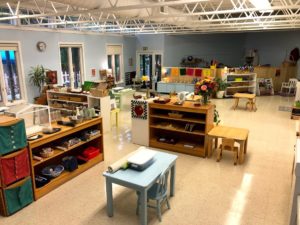Maria Montessori envisioned education for the child as holistic, purposeful, and comprehensive. She saw the goal of education as “the development of a complete human being, oriented to the environment, and adapted to his or her time, place, and culture.” There are three key elements in our AMI (Association Montessori Internationale) recognized programs. These elements distinguish us from traditional models of education.
 1. Mixed-age Classrooms
1. Mixed-age Classrooms
All Montessori programs are comprised of mixed ages. Ages are balanced within the classroom community and children return to the same classroom each year. This mix of ages and consistency of classroom from year to year enable children to lead, to follow, to develop empathy, and to aspire to the “big work” of their older peers. The children freely interact with each other throughout the school day. We find that this freedom leads to the development of self-confident and self-aware individuals who appreciate their responsibility to contribute to community.
2. The Montessori Guide
Children learn in individual ways and at their own pace. The Montessori teacher is a trained observer who will guide each child’s progress in the classroom. Each classroom community at Chesapeake Montessori is guided by one AMI-trained teacher and supported by one assistant. Classroom activities include individual lessons, small group lessons, and whole class lessons. Children acquire self-discipline through learning to make choices in their work, learning to plan and manage their school day, and having the opportunity to become deeply involved in their activities. Freedom and responsibility are both developed through purposeful work chosen by the child. Each environment provides appropriate limits to ensure meaningful choices in a peaceful and busy environment.

3. The Prepared Classroom Environment
Montessori classrooms are equipped with specially designed manipulative materials to aid the child in acquisition or refinement of skills. The materials offer concrete representations of abstract concepts so that children, as they choose, can explore the concept will all of their senses because movement is essential to cognition. Attributes of the prepared environment include order and reality, and beauty and simplicity. Everything is child-sized to encourage independence.
We invite you to learn more about Montessori education and the life and work of Maria Montessori.
- Biography of Dr. Montessori
- The Child’s Development
- A Glossary of Montessori Terms
- Montessori Today by Paula Polk Lillard
- Maria Montessori, A Biography by Rita Kramer
The below video was created by Trevor Eissler, a parent of Montessori students and author of Montessori Madness:
